SUSPENSION PERFORMANCE
All the power in the world useless if it cannot be effectively transferred to the ground to create forward momentum, and that’s magnified on a 450cc motocrosser where high-speed bump absorption can mean the difference between cutting a fast lap time and flailing on a machine that is hard to ride.
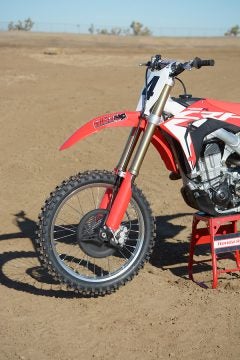
“The Honda’s suspension works great,” Abbatoye said. “It feels plush over the smallest chop, and it is well balanced, which helps the bike to corner well. For tracks with big sand whoops, I might want to stiffen things up a little more, but I love the spring fork, and the rear delivers awesome traction. The shock doesn’t blow through the travel in rough sections. I’m impressed, even with the stock settings.”
While Garvin felt that the stock CRF settings were on the soft side, he found it easy to dial-in and well balanced in all conditions. Novice rider Turner, on the other hand, found the suspension to be a bit firm overall but with nice initial plushness. Burch noted that the Honda fork’s damping is consistent all the way through the stroke, and the rear suspension is “amazing” through choppy bumps, which helps it settle nicely into rough turns.
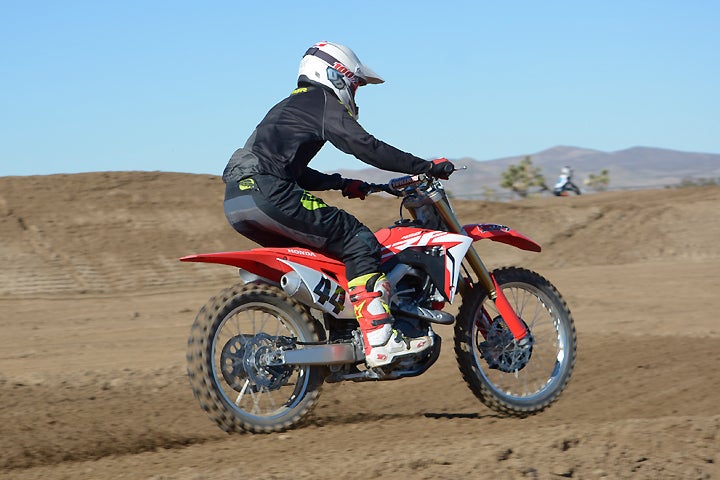
The only knock against the Honda came from Stover, who compared the Honda’s new Showa fork to the KYB SSS coil spring fork on the Yamaha YZ450F and found the Showa wanting. “I don’t think that the Honda’s Showa coil spring fork is as good as the Yamaha’s KYB SSS coil spring fork, but it still offers smooth action,” he said. “I think that the Honda is sprung a little too softly, which makes it comfortable but not quite as controlled as the Yamaha in the chop.”
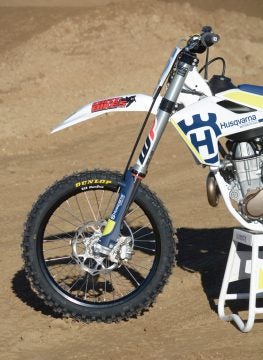
“The WP fork actually works pretty well, although I did have to take out two clicks of compression to like the KTM at first,” Abbatoye said. “Otherwise it’s just too stiff and doesn’t balance with the rear suspension. But once I made that change, the front and rear did a good job everywhere on the track.”
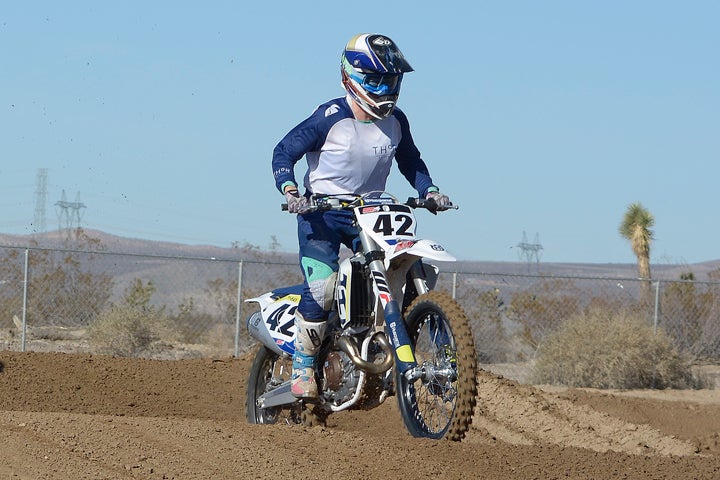
Surprisingly, Garvin found the Husqvarna suspension to be different than the same units found on the KTM Factory Edition.
“I know the Husky and the KTM have the same fork, but for some reason I had a tougher time getting a good feel for the Husky’s front end,” Garvin said. “It didn’t feel bad, but it didn’t feel as good as the KTM. I also found that the Husqvarna’s rear suspension didn’t seem to want to settle down when the track got really rough.”
Our Novice and Expert riders also felt that the Husqvarna was aces in the suspension department.
“I’ve spent some time on 2017 Huskys so I know how good the suspension can be,” Turner said. “The WP air fork is incredible—not just for pro riders! It behaves like an oil/spring fork and has a nice plushness that other air forks don’t have. It’s also very easy to live with and adjust. The sticker on the side of the fork tube makes it very clear to the user, as well. No need to pull out the manual or the smart phone before you start messing with it. Air pressure level is straight forward, and the adjustment knobs are the same as they used to be [with the 4CS]. A+ to WP on the user-friendliness of the AER 48.”
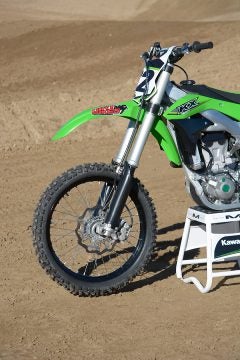
After logging dozens of laps on the KX, air fork skeptic Abbatoye admitted the KX suspension worked better than he thought it would, but overall the Kawi’s suspension drew less than rave reviews.
“It is plush and worked well over fast chop, and it helped the bike to stay in the ruts well,” Abbatoye commented. “The rear suspension also worked well, but it just a little too soft for big G-outs.”
Garvin, however, said that the suspension was “just okay,” and Stover was far less conciliatory. “It was my least favorite of the group,” Stover said. “I think that the KX’s Showa fork is too stiff initially, although it does handle big hits pretty well. Out back, the shock is plush initially, but overall I find its valving to be too stiff. It just has a stiff feeling overall.”
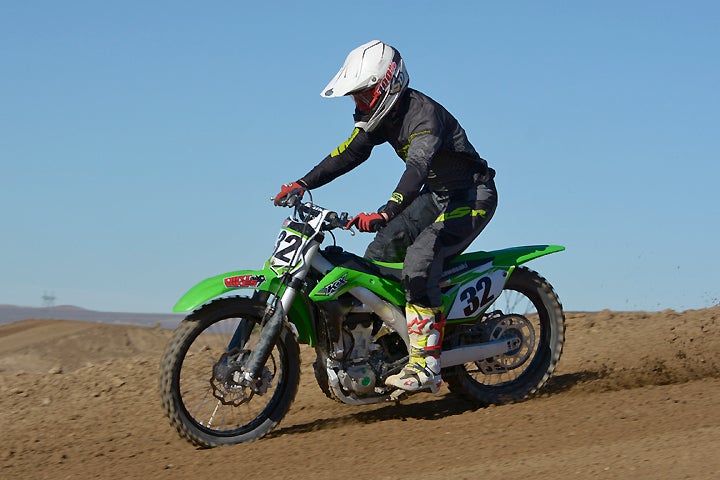
Likewise, Turner called the KX’s fork “a turn-off,” and Burch seemed to be less than impressed with the fork action but happy enough with the shock action. “The Showa air fork on the KX seemed to ride high in the stroke, and I couldn’t get it to settle in,” Burch said. “On the other hand, I thought the shock was great, especially when accelerating out of bumps.”
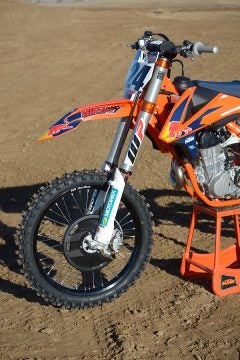
“The KTM fork seemed to be a little stiff at first, and I actually experienced some headshake,” Abbatoye said. “I pulled back in, and we took eight clicks of compression out of the fork. It made a world of difference and solved the problem. It made the fork work really well with the shock everywhere on the track, over large hits or through small bumps. The KTM’s suspension was really balanced, and it helped to give the bike awesome traction.”
Garvin differed slightly again, and Burch agreed with him.
“The AER 48 fork on the KTM is by far the best air fork I have ever ridden,” Garvin said. “It has such a plush yet controlled feel. I feel like I could hit anything with it and be fine. However, I didn’t have as much love for the rear suspension. I couldn’t get it to settle in to my liking when I was going into corners.”
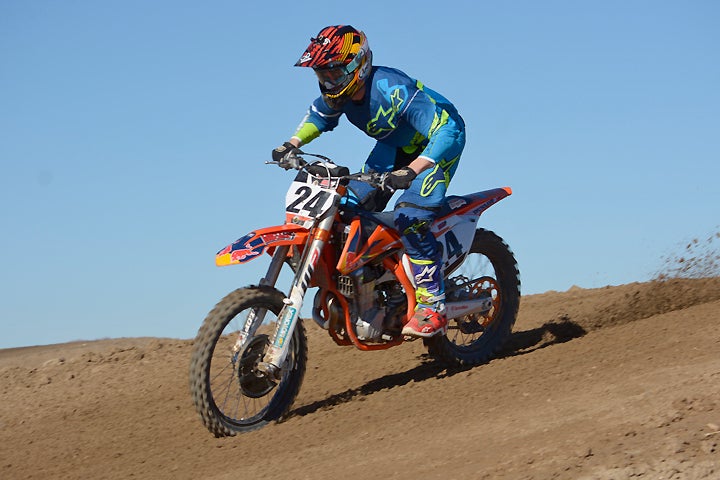
Stover was still not bowled over by the WP fork or the KTM/Husky suspension in general.
“I like the KTM’s fork action, which seems to work well over a wide range of terrain, but I still think that the Yamaha’s KYB coil spring fork works better,” Stover said. “Overall, the KTM’s valving is on the stiff side, but I don’t really have any complaints about how it goes through the stroke at either end.”
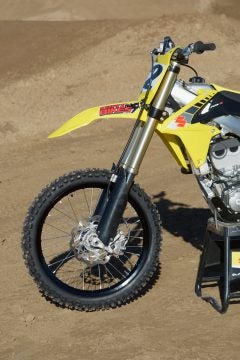
Compared to the rest of the group, the Suzuki drew the most negative comments for the way it dealt with small and big hits.
“The Suzuki feels well-balanced, but overall its suspension action is just too rigid and harsh for my tastes,” Abbatoye said, and Garvin was even less impressed. “I would swap the Suzuki’s Showa air fork off the bike if I owned it,” Garvin complained. “The fork was harsh no matter what I tried. It actually hurts what might be decent rear suspension action. The shock really needs a better fork to help it realize its full potential.”
Turner agreed, saying “That fork… we were not able to dial any of the harshness out of it. Landings sent a sting to my hands.”
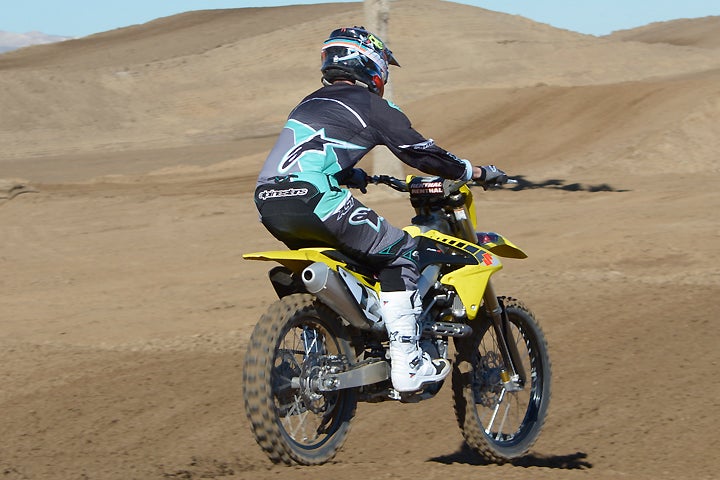
But not everyone was willing to hammer the Suzuki’s suspension performance. Burch and Stover were able to find some happiness with the RM-Z’s suspension.
“Once you get into the stroke, I think the Suzuki forks are reasonably plush,” Burch said. “Once I made some adjustments to the high-speed compression setting, the rear of the bike actually handled choppy bumps really well and felt great at higher speeds.” Stover simply said, “I thought that the Suzuki’s suspension wasn’t great over small bumps, but it was progressive enough for me.”
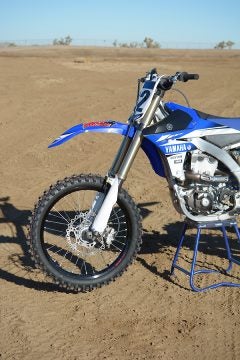
The Yamaha still ranks well in the face of newer suspension designs from Honda and KTM/Husqvarna, although some testers felt that the YZ is starting to lose some ground.
“I love the KYB coil spring forks on the Yamaha,” Abbatoye said. “They worked really well after we backed the compression off a few clicks from stock. They can really handle rough ground well, and that only helps the Yamaha to be even more stable over rough ground. The shock is really in balance with the fork—not too soft or too stiff. It really works well over big G-outs.”
Stover called the YZ’s suspension action smooth and progressive. “I didn’t feel like it was harsh anywhere on the track,” he said. “On the other hand, I had to dial the shock so that it was quite a bit softer than stock just to get it so that it had a settled feel.”
After riding all of the bikes in the class, though, Garvin said he sees the writing on the wall.
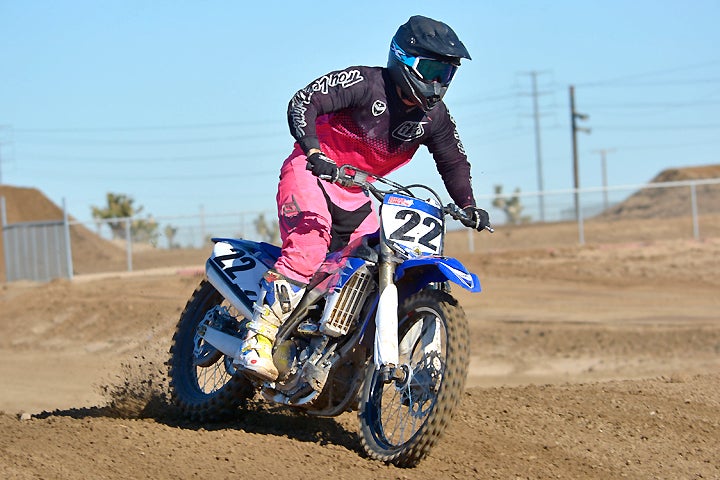
“The Yamaha has had pretty good suspension for a long time, but compared to the newer bikes in this class it needs some updating,” Garvin said. “I found both ends to be a little too stiff for my liking when ridden over rough sections. The suspension seems to react to everything.”
 Your Privacy Choices
Your Privacy Choices